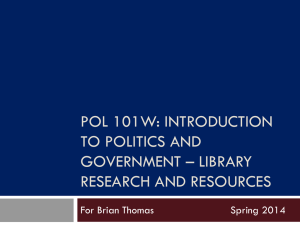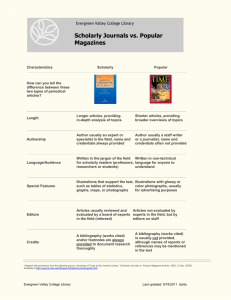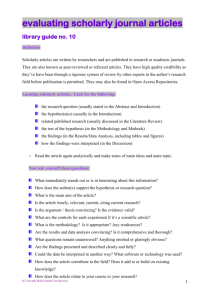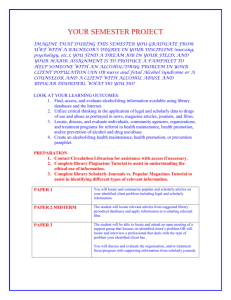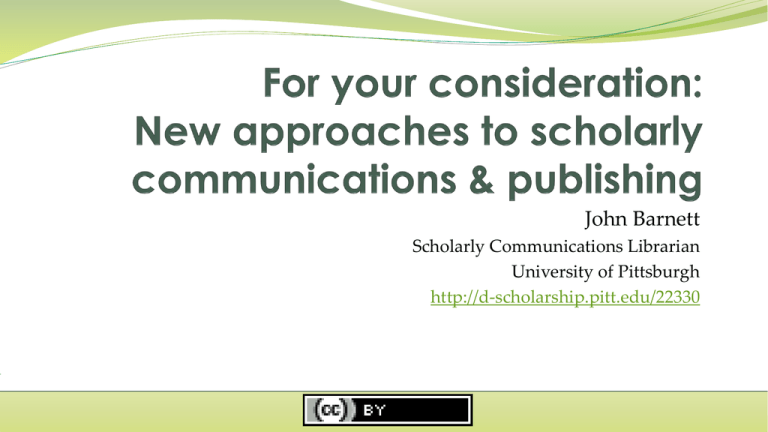
John Barnett
Scholarly Communications Librarian
University of Pittsburgh
http://d-scholarship.pitt.edu/22330
Today’s goals
What in the world is “scholarly communication”?
Advice Information for graduate students and early career researchers
Copyright +
Open access to research
Measuring scholarly impact
Resources to go (pro tips)
Your turn
But first, a disclaimer . . .
I’m a librarian, not a scholar, not an early career researcher
I can offer ideas, suggestions, and opinions
This is most definitely not legal advice
Nor is it professional advice (for your profession)
Ultimately, you have to do what you believe is best for your career
I’m learning, too
Scholarly communications 101
“The creation, transformation, dissemination, and preservation of
knowledge related to teaching, research, and scholarly endeavors”
“The process of academics, scholars and researchers sharing and
publishing their research findings so that they are available to the wider
academic community”
So, simply stated, it’s the process of scholars sharing their research
results with the wider world
Pro tip #1: SC glossary
http://www.library.pitt.edu/oscp/glossary
Prone to flooding
Graduate students and Early Career Researchers (ECRs) report
Writing blog posts about their research and teaching
Publicizing their work on social media
Finding collaborators via social networks and blogs
Sharing papers on Academia.edu, ResearchGate, Mendeley, etc.
New scholars invest a lot of time in social media and dissemination—
time that could be used for research
How do you manage all of these information streams?
How can librarians and others help?
Copyright & other intellectual property
Librarians and libraries deal with this a lot
Contracts for electronic resources or special collections
Public performance rights
Face-to-face teaching
Distance education
Citation and reuse of others’ works
Fair use
No advice please
Generally, librarians can only suggest or guide
We cannot and should not give legal advice
Others may be able to help
General counsel
Computing and technology services
Distance education
A copyright or contract law specialist
Pro tip #2: Copyright resources
Copyright Basics (Circular 1 from the U.S. Copyright Office)
U.S. Copyright Law, Title 17 of the U.S. Code
World Copyright Terms
Your university’s copyright and intellectual property policies
Your university’s compliance with the Technology, Education, and
Copyright (TEACH) Act – nonprofit educational use of copyright
protected works in distance education
Digital Millennium Copyright Act (Appendix B, U.S. Copyright Law) –
copyright in the digital environment
Pro tip #3: How long does it last?
It depends (on where and when the work was published)
The short version: Most new works are protected for the life of the
author + 70 years
Works published before 1978 were required to have a copyright notice;
this is no longer the case—but the work is still protected
Works published between 1923 and 1978 could have protection for up
to 95 years
Is It Protected by Copyright? For Works First Published in the U.S.A.
ULS Copyright FAQ
Pro tip #4: Keeping up with copyright
Copyright Advisory Office Blog (Columbia University Libraries)
Direct Dispatch: ALA Washington Office Blog
SPARC Blog and SPARC News & Media
Kip Currier Copyright and “Open” Movements Blog
Fair use
The rights of copyright owners are subject to limitations
A fair use of a copyrighted work might include criticism, comment,
news reporting, teaching, scholarship, and research
Four factors for determining fair use
The purpose and character of the use (commercial, nonprofit, etc.)
The nature of the copyrighted work (factual or creative)
The amount and substantiality of the portion used
The effect of the use upon the potential market for, or value of, the work
“There is no specific number of words, lines, or notes that may safely be
taken without permission”
Pro tip #5: Determining fair use
Try to learn how to determine fair use on your own—but don’t be
afraid to ask for help
U.S. Copyright Office factsheet on fair use
Thinking through fair use (University of Minnesota)
Fair use checklist (Columbia University)
Other resources to help with images and other types of IP
ULS Copyright FAQ on fair use
Copyright with something extra
Creative Commons licenses
Alternative to “all rights reserved”
Enables authors/creators to apply copyright terms to their works in a
way that allows others to use, build upon, and share your creations
while still getting credit
Multiple licenses = more compatible with web activities and
communication
Pro tip#6: CC licenses
Author agreements
Librarians may not be able to advise university authors
Your institution’s general counsel may not advise you either . . .
But you can be better informed about the language used and its
meaning in author agreements—and librarians can often help with that
A publisher may or may not accept these terms—but at least you will
better understand your agreements (and may be able to effect change
over time)
Pro tip #7: Terms of agreement
SPARC Author Addendum for Author Rights
Developed by the Scholarly Publishing and Academic Resources Coalition
(SPARC)
A legal tool used by authors to modify publisher agreements to keep key
rights, such as archiving, redistribution, etc.)
Scholars’ Copyright Addendum Engine (SCAE)
Developed by Science Commons
Non-exclusive rights to create derivative works and to reproduce,
distribute, publicly perform, and publicly display your article in
connection with teaching, conference presentations, lectures, other
scholarly works, and professional activities.
Pro tip #8: SHERPA RoMEO
SHERPA RoMEO
Database of publisher copyright and author self-archiving policies
Developed by the University of Nottingham but aims to be international in
scope (better coverage of the English-speaking world)
Open access to research
Open access literature is digital, online, free of charge, and free of most
copyright and licensing restrictions.
Peter Suber, Open Access. MIT Press. 2012
What OA is and isn’t
Open access is compatible with . . .
Peer review
Promotion and tenure criteria
Copyright law
Revenue and profits
Any genre or format
OA does not . . .
Equal low quality
Constitute vanity publishing
Violate copyright
Reduce author choice or academic freedom
Where did OA come from?
Significant and continual growth in scholarly publishing
≈50 million research articles published 1665-2009
≈1.35 million journal articles published per year (2006 est.)
Average number of science articles per journal increased from 185 to 273 from 1990 to 2009
Number of scientific articles indexed by ISI was <600,000 in 1990 & >1 million in 2009 – a rise of 72%
Rise of the Internet and the Worldwide Web
Concern among libraries
Huge costs and price increases for journals, electronic resources
Concentration of ownership among handful of publishing companies
Sources: Jinha (2010), Bjork et al. (2009), & Jump (2010)
Pro tip #9: All about OA
ULS Open Access LibGuide
OA explained, origins, resources, tools
Open Access Week
An international commemoration of OA
Open Access by Peter Suber
Being Open as an Early Career Researcher
Presentation by Erin McKiernan, neuroscientist
WTFINRESEARCH?!
A Tumblr that encourages you to “share the irony” of articles about open
access published in closed access journals
OA policies
Faculty adopted
Institution-wide
College or departmental
Author grants institution non-exclusive right to post online for open access
scholarly articles written by the researcher
Faculty members retain copyright to articles and can turn copyright over to a
third party, such as a publisher
Faculty may be discouraged from signing publishing contracts that prohibit
OA posting but usually receive an exemption
An institutional repository may be designated as the official distributor for
faculty works
134
Articles
9,772
Countries
Journals
Open access journals (DOAJ)
1,646,119
Other open models
Open educational resources (OERs)
Teaching and learning materials freely available online for everyone to use
Examples: Full courses, course modules, syllabi, lectures, homework
assignments, quizzes, lab and classroom activities, pedagogical materials,
games, simulations, and many more
Open textbooks
A type of OER
Open data
Data that are freely available to use and republish, without copyright or
patent restrictions
Open source software
Pro tip #10: Finding open content
Repositories –
OpenDOAR
Journals –
Directory of Open Access
Journals (DOAJ)
Books –
OAPEN
Knowledge Unlatched
Educational resources (OERs) –
Merlot
OER Commons
Data –
DataOne (NSF-funded)
Dataverse Network Project
(Harvard-sponsored)
Dryad (science, medicine)
Figshare (commercial)
Scholarly concerns about OA
Quality (of peer review and content)
OA isn’t self-publishing
Bad peer review can affect both subscription and free journals
Cost (“paying to publish”)
Generally only OA journals in STEM disciplines have article-processing
charges (APCs)
A fear of being scooped or plagiarized
The worry over prestige = “OA won’t help me with tenure and
promotion”
Pro tip #11: Beall’s List
Beall’s List: Potential, Possible, or Probably Predatory Scholarly Open-
Access Publishers
Compiled by Jeffrey Beall, a librarian at Auraria Library, Colorado
Also provides a list of criteria for determining predatory publishers
Also see Open Access Scholarly Publishers Association (OASPA) Code
of Conduct
And Committee on Publication Ethics (COPE) Code of Conduct for
Journal Publishers
ULS e-journal publishing
The library as publisher
Publish more than 35 OA journals in a variety of disciplines and
languages
Publishing partners at Pitt and around the world
Using the Open Journal Systems (OJS) platform from Public Knowledge
Project (PKP)
My life as a journal editor
Co-editor of Pennsylvania Libraries: Research & Practice (PaLRaP)
Sponsored by the College & Research Division, Pennsylvania Library
Association
Published by the ULS e-journal program
Online, peer-reviewed, OA journal for/by/about PA libraries and library
professionals
Focus on academic libraries but welcome contributions from all libraries
Includes research and practice articles, features, commentaries, and news
Publish twice a year; now preparing for our 4th issue
A learning experience
Soliciting contributions
Evaluating research
Communicating with authors and reviewers
Developmental editing, copyediting, and layout
Training in use of the platform, editorial practices, writing, and research
Promoting and fundraising
It’s a lot of work! (But it’s fun, too)
Measuring research impact
Bibliometrics
Alternative metrics (altmetrics)
Defining bibliometrics
The branch of library science concerned with the application of
mathematical and statistical analysis to bibliography; the statistical
analysis of books, articles, or other publications (OED Online)
In other words…data about publications or citation frequency
Source: Kear (2014)
Why bibliometrics matter
They may help answer questions such as
What are the best journals in my discipline? (Or most cited?)
Who is citing my articles?
How many times have I been cited? And where?
How do I know this article is important?
Which journal should I publish in?
Source: Kear (2014)
Some concerns
Accuracy
Comprehensiveness
Journals only—what about books and proceedings?
Location and language of the journal
Disciplinary coverage
Reliance on the Journal Impact Factor (without understanding it)
Is it possible to game the system?
Scholarly “worth” reduced to a number (which may or may not have
real meaning)
Journal impact tools and measures
Journal Citation Reports
Article Influence
(Thomson Reuters)
Scopus (Elsevier)
Eigenfactor
Impact Factor
Journal Analyzer
SNIP
SJR (SCImago Journal Rank)
Source: Kear (2014)
Citation tools and measures
Citation Map (Web of Science)
H-index (researchers impact)
Citation Reports (Web of Science)
H-graph (depicts impact of a set
Citation Tracker (Scopus)
of articles
Source: Kear (2014).
Research evaluation tools
Generally used at the institutional level to evaluate research impact
SciVal (Elsevier Scopus dataset)
InCites (Thomson Reuters Web of Science)
Symplectic Elements (orange—different focus to the others)
Pro tip #12: Understanding bibliometrics
ULS LibGuide: Citation Searching and Bibliometric Measures
By Robin Kear, University of Pittsburgh
Robin’s handout
Scholarly Communication Lunch and Learn Talk #8: Using Bibliometric
(Publication and Citation) Indicators to Demonstrate Impact
By Berenika Webster and Robin Kear, University of Pittsburgh
Bibliometrics Seminar held at Pitt (22 May 2014)
Presentations and recordings
Pro tip #13: Explore the DORA
San Francisco Declaration on Research Assessment
Initiated by the American Society for Cell Biology + a group of editors
and publishers of scholarly journals
1 general recommendation
Do not use journal-based metrics, such as Journal Impact Factors, as a
surrogate measure of the quality of individual research articles, to assess an
individual scientist’s contributions, or in hiring, promotion, or funding
decisions
17 specific recommendations
Funding agencies
Consider the value and impact of all research outputs (e.g., datasets, software) in addition
to research publications
Institutions
Be explicit about the criteria used to reach hiring, tenure, and promotion decisions
Publishers
Greatly reduce emphasis on the journal impact factor as a promotional tool
Organizations supplying metrics
Be open and transparent by providing data and methods used to calculate all metrics
Researchers
When involved in . . . Making decisions about funding, hiring, tenure, or promotion, make
assessments based on scientific content rather than publication metrics
Defining altmetrics
Altmetrics = Alternative ways of measuring the use and impact of
scholarship
Altmetrics combine traditional impact measures (citation counts) with
non-traditional measures
“Altmetrics are measures of scholarly impact mined from activity in
online tools and environments” – Jason Priem, Co-Founder, ImpactStory
Altmetrics = All metrics
The benefits
More comprehensive
Citations, usage, social media
Covers impact of online behavior
Because scholars increasingly work online
Measures impact immediately
Because citation counts take years to appear in literature
Show impact for early career faculty & graduate students
Good numbers = potential for further publishing, research,
employment, and funding?
Some concerns
Prestige and tenure are often still locked into Journal Impact Factor
Apples and oranges?
A “like” is not the same as a citation
Older vs. newer works
Newer works may receive more attention from social media
Gaming the system
Also a concern with traditional metrics
Altmetrics services
PlumX at Pitt
Profiles for researchers, schools,
departments, labs, and more
Researcher-level widgets
Journal article-level widgets
Repository item-level widgets
Data in blue are hyperlinked so we can find out
more about the downloads and tweets
Data in gray are not hyperlinked so no further
information is available—at least at this time
Pro tip #14: Easy intro to altmetrics
Impactstory
Created by scholars and funded by Open Society Foundation, Alfred P. Sloan
Foundation, National Science Foundation
See where works have been cited, viewed, downloaded, tweeted . . .
Reports impact of articles, slides, datasets, software
Free!
Talkwalker Alerts
Create alerts about yourself or your research
Talkwalker monitors social media and online media and alerts you when there’s
something of interest being discussed
Free!
Alternative to Google Alerts
Pro tip #15: Rubriq
Rubriq – “explore the possibilities of independent peer review”
For a fee, Rubriq will conduct peer review of your manuscript on your
behalf
Rubriq reviewers will give feedback and recommend journals that are
the best match for your work
This is untried by me but sounds interesting . . .
Your turn
John Barnett
Scholarly Communications Librarian
Office of Scholarly Communication and Publishing
University Library System, University of Pittsburgh
jhb23@pitt.edu or oscp@mail.pitt.edu
Twitter: @OSCP_Pitt
Sources
Bjork, B., Roos, A., and Lauri, M. (2009). Scientific journal publishing: Yearly
volume and open access availability. Information Research 14(1), paper 391.
http://InformationR.net/ir/14-1/paper391.html
Jinha, A. (2010). Article 50 million: an estimate of the number of scholarly
articles in existence. Learned Publishing 23(2), 258-263. doi:10.1087/20100308
Jump, P. (2010). The expanding universe of scientific authorship. Times Higher
Education Supplement (8 July 2010), 10.
Kear, R. (2014). Citation and bibliometric measures. LibGuide. Retrieved from
http://pitt.libguides.com/bibliometrics
Suber, P. (2012). Open access. MIT Press. http://mitpress.mit.edu/books/openaccess

